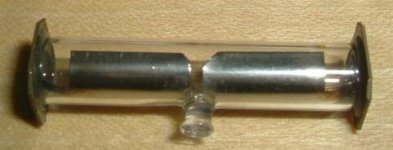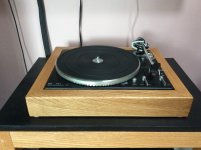Well, well. To my old eyes it looked like a large fuse wire.
Is there a way to check it, or the circuit?
Thanks
Is there a way to check it, or the circuit?
Thanks
There really aren't too many components regarding the strobe. Have a look at the schematics:
The components are the lamp Gl. 1, the diode D51, the capacitor C51 and two resistors R51 and R52. You can check them easily. But the lamp remains the most suspicious culprit.
Best regards!!
An externally hosted image should be here but it was not working when we last tested it.
The components are the lamp Gl. 1, the diode D51, the capacitor C51 and two resistors R51 and R52. You can check them easily. But the lamp remains the most suspicious culprit.
Best regards!!
If you have removed the Neon, and are in 120V land, wire the neon in series with 47K resistor and *carefully* connect to 120V. It should light "steady". They do get weak over the decades. Old neons typically flicker, or work in the light but not in the dark.
This way with raw AC, the "steady" glow (if any) is really a 120Hz flicker. The Dual adds a bunch of parts which seem to make it a 60Hz flicker, so they can use half as many wider strobe-bars for a nicer pattern.
Neons can still be bought from China, but LEDs make a lot of sense now.
This way with raw AC, the "steady" glow (if any) is really a 120Hz flicker. The Dual adds a bunch of parts which seem to make it a 60Hz flicker, so they can use half as many wider strobe-bars for a nicer pattern.
Neons can still be bought from China, but LEDs make a lot of sense now.
Neons can still be bought from China...
Are you sure? The Dual strobe neon is a tubular one, about 1" long and 1/4" dia. The terminals, small quadratic plates, are at the ends. I doubt that one still can buy them today from somewhere.
Best regards!
Neons can still be bought from China, but LEDs make a lot of sense now.
You can by Neons, not only from China. But i doubt, that you can by a neon that works as a 1:1 replacement for the Dual players.
If you have a dealer in China who sells these bulbs, let me know.
LEDs work great, but please use an orange one 🙂 I've seen so many with a blue LED replacement 😡
It's a DUAL not a Pass 😀
Micha
Attachments
And don't try to replace it by a, say, NE2. Too dull...
Btw, I just saw that the Austrian vendor mentioned in #18 has retracted his LED replacement 😡.
Best regards!
Btw, I just saw that the Austrian vendor mentioned in #18 has retracted his LED replacement 😡.
Best regards!
Last edited:
Thank you Micha.
I am familiar with the little plastic device, but I suspect the restricted vertical movement of the tonearm is being caused by something else. Unless it is normal.
Just trying to gather information before I look underneath.
It's been a long time since I did "disassemble clean and lube" on turntables, particularly Duals. I would bet that clean/lube and replace the "steuerpimpel" would cure your problems. The shape of the plastic part looks a lot like a crutch tip, only hundreds of times smaller and I suspect it fails the same way.
The arm motion in a Dual comes from the main lever that rides in the 3D plastic umbrella cam. The lever first moves vertically to engage the "pimpel" to raise the arm. The lever then moves laterally to move the arm into position. The lever then moves vertically to lower the arm. The condition of the pimpel is critical to the operation of the unit.
The original lubricant on the cam was Shell Alvania #2. That may be difficult to find but Nye 368AX1 is a synthetic suitable substitute. Wacker siliconoil
was used as the damping fluid so the arm settles slowly. I don't know what the replacement would be.
By the way, someone is destroying those arm bearings.
Since this IS DIY audio I'm sure someone (I know I can) come up with a satisfactory LED replacement for the strobe. An unfiltered bridge rectifier on the secondary side of the transformer feeding a comparator to square up the rise/fall times driving a high brightness LED should work fine.
The original neon strobe triggers on both phases of the AC (why you need the unfiltered bridge) and squares up itself when it hits the threshold Voltage
(why you need the comparator).
I wish you luck.
G²
The steuerpimpel is working fine after I cleaned away excess lube.. in fact the entire auto mechanism is a joy to watch and very smooth and quiet.
The arm moves smoothly and tracks a dream, so I assume the bearings are ok. I even disassembled the counterweight to see why the rear weight was sagging. It looks somewhat better now but I imagine the spring that suspends the weight is fatigued and calibrating it is beyond my capabilities. All in all, a great turntable to watch as well as listen to.
Next will be a hardwood plinth, either walnut or oak.
Peter
The arm moves smoothly and tracks a dream, so I assume the bearings are ok. I even disassembled the counterweight to see why the rear weight was sagging. It looks somewhat better now but I imagine the spring that suspends the weight is fatigued and calibrating it is beyond my capabilities. All in all, a great turntable to watch as well as listen to.
Next will be a hardwood plinth, either walnut or oak.
Peter
Btw, I just saw that the Austrian vendor mentioned in #18 has retracted his LED replacement 😡.
Best regards!
dualfred still sells them. I've never used one of his LED replacements so I don't no nothing about the quality.
dualfred - Stroboskoplampe LED orange
Micha
- Status
- Not open for further replies.
- Home
- Source & Line
- Analogue Source
- Dual 721 question

